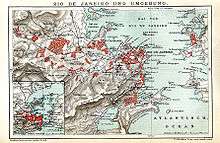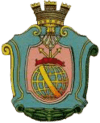Neutral municipality
| Neutral municipality Município Neutro | |||
|---|---|---|---|
| Former State | |||
| |||
.png) Map of the Neutral municipality in 1880. | |||
| Coordinates: 22°54′S 43°11′W / 22.900°S 43.183°W | |||
| Country |
| ||
| Established | 1834 | ||
| Dissolved | 1889 | ||
| Seat | Rio de Janeiro | ||
| Area | |||
| • Total | 1,356 km2 (524 sq mi) | ||
| Population (1872) | |||
| • Total | 274.972 | ||
| • Density | 0.20/km2 (0.53/sq mi) | ||
| Demonym(s) | carioca | ||
Neutral municipality (Portuguese: Município Neutro) [1] It was the name of the administrative status of the city of Rio de Janeiro, between 1 August 12, 1834, when it was proclaimed the Additional Act to the Brazilian Constitution of 1824 and November 15, 1889, when the republic was proclaimed in Brazil. But only ceased to officially exist, with the promulgation of the Constitution of 1891. For the republican constitution, this administrative unit was renamed Federal District, whose political situation changed again with the creation of the state of Guanabara in 1960 and later with the merger this with the state of Rio de Janeiro in 1975.
History

After the transfer of the Portuguese Court to the city of Rio de Janeiro, the autonomy that the province of Rio de Janeiro both aspired was not achieved in the same way that other Brazilian provinces, as the minister of the Kingdom, a position he was virtually a substitute for the Viceroy regarding Rio de Janeiro, its administration was entrusted.
Added to this was the fact that the city of Rio de Janeiro was the imperial capital, which meant that the minister should administer the entire province through "notices", which drove the city councils of cities that at that time, grew by leaps and bounds due to expansion and strengthening of coffee plantations in the Paraíba Valley, which already surpassed the strength of sugarcane plantations in the northern region of the province.
These differences in relation to other administrative units of Empire of Brazil made in the year 1834 the municipality of Rio de Janeiro was transformed into Neutral Municipality, remaining as the capital, while the province now has the same political and administrative organization of the others, with its capital in Vila Real da Praia Grande, which the following year was renamed Nictheroy (current Niterói).
Already the city of Rio de Janeiro went on to have a town hall, which would take care of the life of the city without interference from the province and president in 1889, after the establishment of the Republic in Brazil, the city continued as the capital of Brazil, and then Neutral municipality turned to Federal District. With the move of the capital to Brasilia, the former Federal District became the state of Guanabara.

